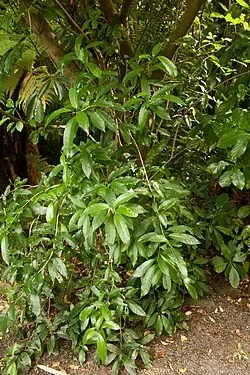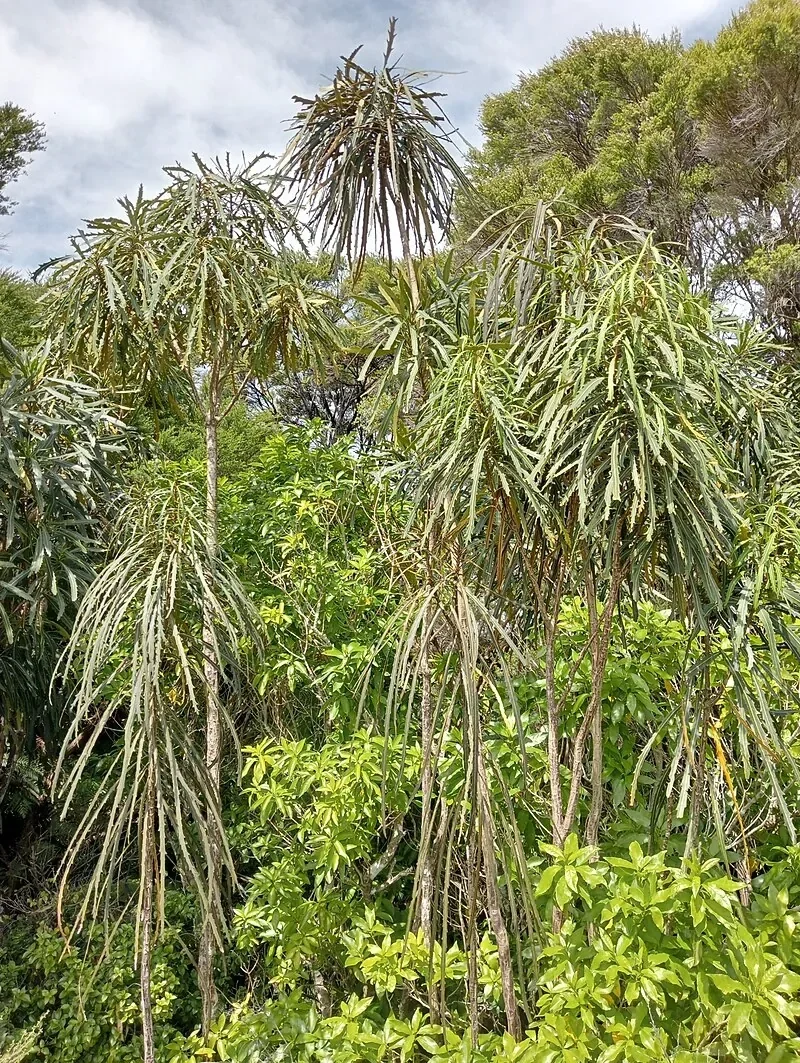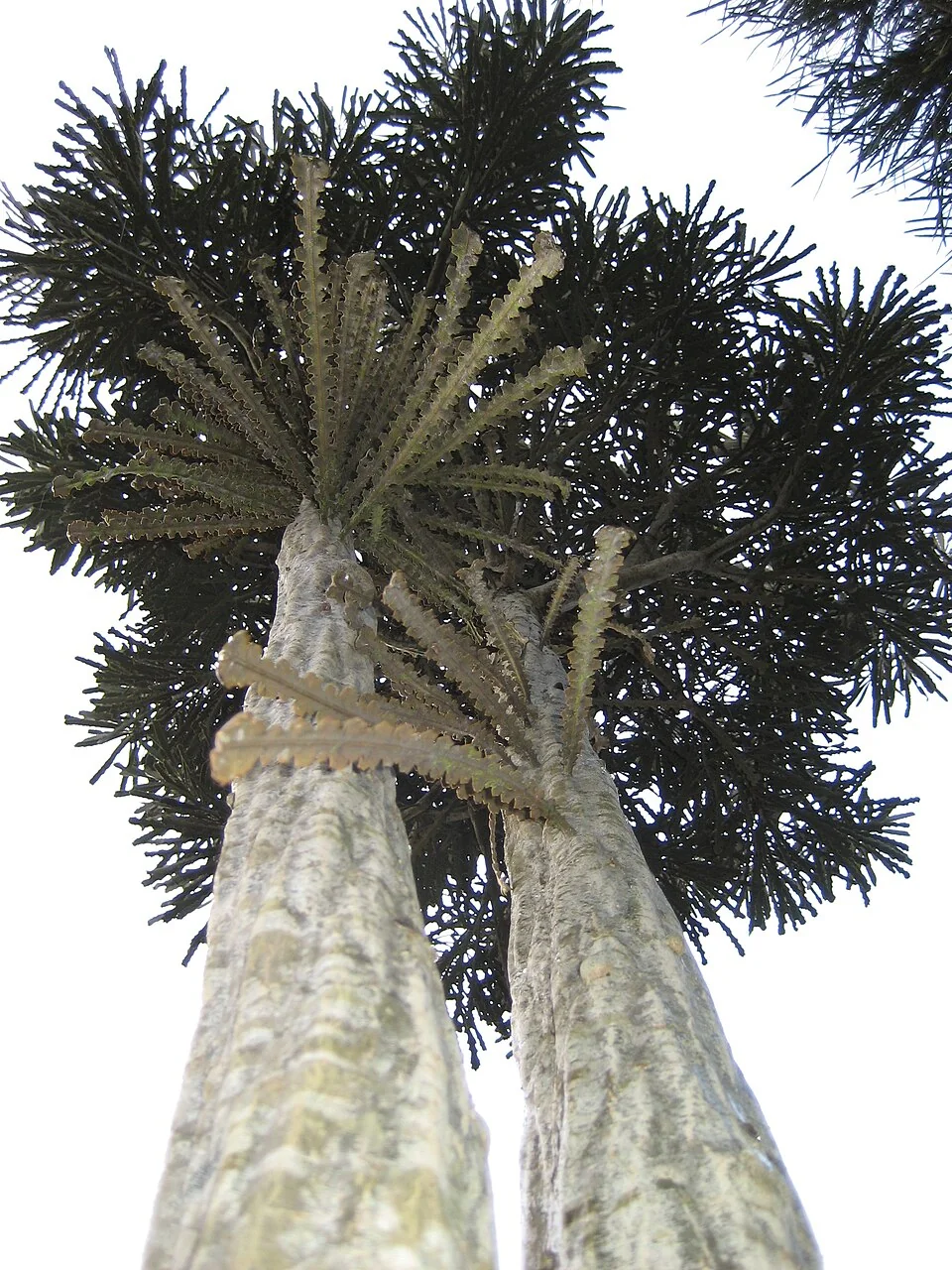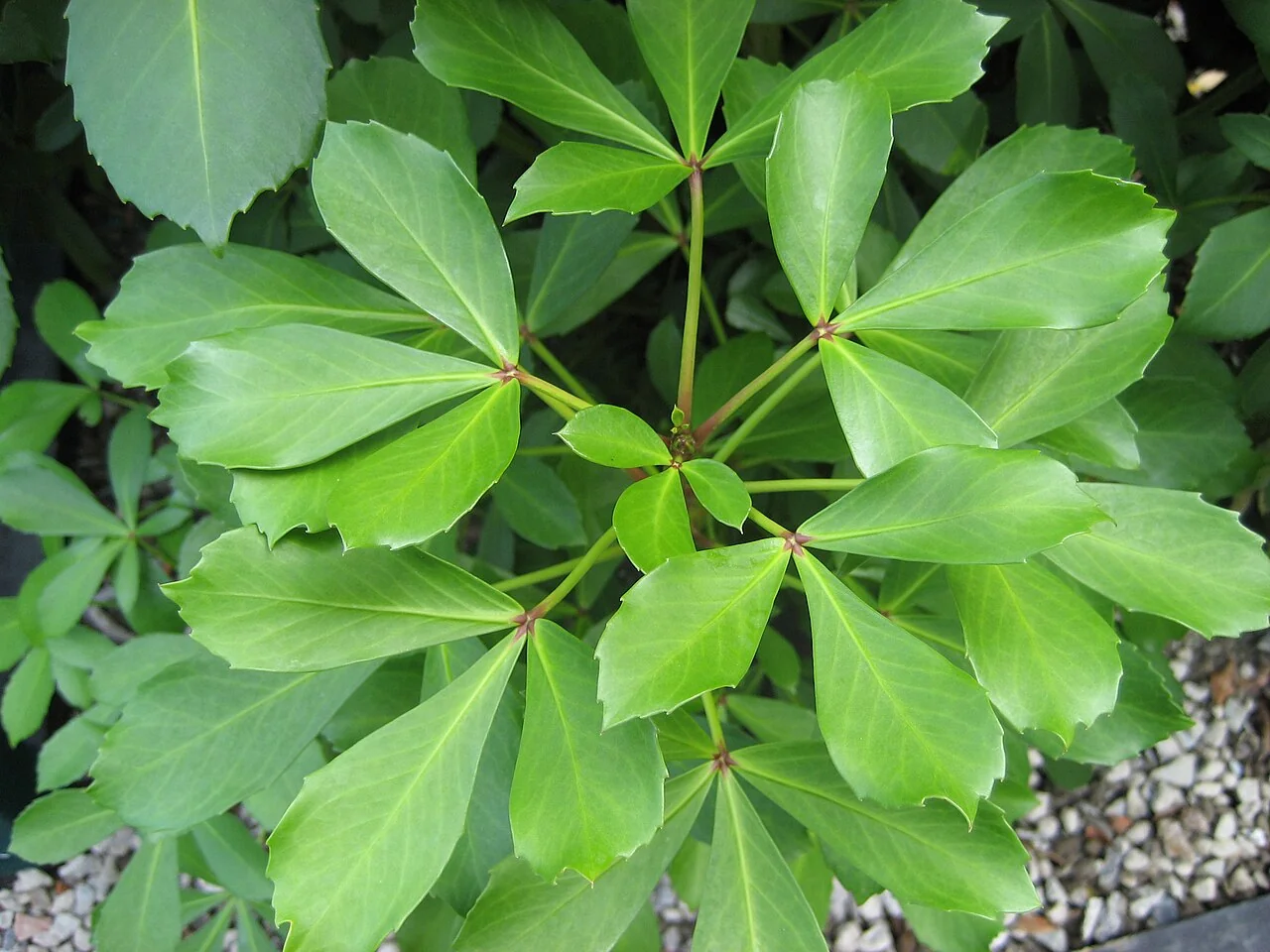
Five Finger
Pseudopanax arboreus
Introduction
Introduction Overview
Five-finger ( Pseudopanax ) is a fast-growing native New Zealand tree with distinctive five-fingered leaves and clusters of small purple berries. It is valued for its ornamental foliage and as a food source for native birds. native trees .

Plant Description
Botanical Features
Five Finger ( Pseudopanax arboreus ), also known as whauwhaupaku or puahou, is a native New Zealand tree belonging to the family Araliaceae. It is a common, fast-growing, multi-branched tree that can reach up to 8 meters tall, though typically 4-6 meters, with brittle branches and branchlets. Its most distinctive feature is its glossy, hand-shaped, compound leaves, which typically have five to seven leaflets radiating from a central stalk, giving it the common name "five-finger." These leaflets are obovate-oblong to oblong-cuneate, thinly leathery (coriaceous), and have coarsely serrated or toothed edges. The petioles (leaf stalks) are about 15-20 cm long, sheathing the branchlet at the base, and the petiolules (stalks of the leaflets) are pale green and about 3-5 cm long. It produces small, sweet-scented flowers, usually unisexual, that are about 5 mm in diameter. These flowers are typically white to pink-flushed and appear in compound terminal panicles with numerous rays and umbellules. Flowering occurs in winter (June to August in New Zealand). The flowers are followed by fleshy, very dark purple, laterally compressed fruits, 5-8 mm in diameter, which contain 2-3 wrinkled seeds. These fruits are enjoyed by birds from August to February.
Quick Facts
Quick Facts Overview
| Scientific Name | Pseudopanax Arboreus |
|---|---|
| Height | Up to 8 m |
| Spread | 3-5 m (broad, rounded crown) |
| Water Needs | Moderate; prefers moist, well-drained soil |
| Light | Partial shade to full sun |
| Frost Tolerance | Moderate (tolerates light to moderate frost) |
| Salt Tolerance | Low to moderate (tolerates some coastal exposure) |
| Growth Rate | Fast |
| Lifespan | Long-lived (decades) |
Climate Best Suited to
Pseudopanax is native to New Zealand and thrives in the country's diverse climate conditions. It adapts well to various regional climates throughout the country.
Regional Suitability
| City | Climate Suitability |
|---|---|
| Whangārei | Ideal |
| Auckland | Ideal |
| Hamilton | Ideal |
| Tauranga | Ideal |
| Rotorua | Ideal |
| Gisborne | Ideal |
| New Plymouth | Ideal |
| Napier | Ideal |
| Whanganui | Ideal |
| Palmerston North | Ideal |
| Wellington | Ideal |
| Nelson | Ideal |
| Christchurch | Ideal |
| Dunedin | Ideal |
| Invercargill | Ideal |
Natural Habitat
Natural Habitat Overview
Pseudopanax arboreus is naturally found in specific habitats throughout New Zealand. Understanding its natural environment helps in providing appropriate growing conditions in cultivation.
Plant Conservation
Conservation
Pseudopanax arboreus , commonly known as five-finger or whauwhaupaku, is a native New Zealand tree that is currently not considered threatened. Its conservation status is listed as "Not Threatened" by the NZPCN and "Least Concern" by the IUCN. Despite its secure national status, some factors are relevant to its conservation. Possums ( Trichosurus vulpecula ) are known to feed on the petiolules (leaf stalks) of Pseudopanax arboreus , and other fleshy-leaved Pseudopanax species, which can result in discarded leaflets littering the forest floor. Deer and goats also pose a threat to its populations through browsing. This species thrives in moist broadleaf forests, streamsides, and forest margins, ranging from coastal to montane elevations. It is also a common component of secondary forests. Pseudopanax arboreus plays a role in its ecosystem as a host plant for the caterpillar of the endemic North Island moth Declana atronivea . Its flowers provide valuable pollen and nectar for bees, particularly early in the season, and its dark purple fruits are a food source for birds, which assist in seed dispersal. The tree is widely used in gardens and restoration initiatives, indicating its value in ecological restoration efforts.
Soil Requirements
Pseudopanax prefers well-draining soil with good organic content. It can adapt to various soil types but performs best in loamy or sandy soils.
Water Needs
Pseudopanax requires moderate watering, especially during establishment. Once established , it becomes more drought-tolerant.
Light Requirements
Pseudopanax grows best in full sun to partial shade, depending on the specific species and local climate conditions.
Temperature
Pseudopanax is well-adapted to New Zealand's temperate climate and can tolerate both warm summers and cool winters.
Planting Guide
When to Plant
The best time to plant Pseudopanax is during spring or autumn when soil temperatures are moderate and rainfall is reliable.
How to Plant
Dig a hole twice the width of the root ball and slightly deeper. Place Pseudopanax in the hole, backfill with soil, and water thoroughly. Mulch around the base to retain moisture.
Ecological Role
Wildlife Interactions
This plant plays an important ecological role in New Zealand's native ecosystems. It provides habitat and food for native wildlife and contributes to ecosystem health and biodiversity.
Uses and Applications
Practical Applications
Pseudopanax has various practical and ornamental uses. From traditional Māori applications to modern landscaping, this versatile plant serves multiple purposes.
Historically, Pseudopanax was used by Māori for medicinal purposes, food, and cultural practices. These traditional uses reflect the deep knowledge of native plants.
Landscaping Uses
Landscaping Uses Overview
This plant is highly valued in landscaping for its aesthetic appeal and practical benefits. It can be used in various garden styles and landscape applications.
Seasonal Care
Maintain consistent moisture for Five Finger by watering regularly, especially during dry periods, to support its rapid growth. Prune lightly after flowering to maintain shape and encourage bushiness if needed. Apply organic mulch around the base to retain moisture, suppress weeds, and regulate soil temperature throughout the year.
Spring
Summer
Autumn
Winter
Pruning
Pruning Techniques
Prune lightly in spring to maintain shape. Remove dead or damaged branches.
Regular pruning of Pseudopanax helps maintain its health and desired shape. Remove any dead, diseased, or crossing branches to improve air circulation and reduce the risk of pest and disease problems.
For most native plants, light pruning throughout the growing season is better than heavy pruning at once. This approach encourages healthy new growth while maintaining the plant's natural form and character.
How to Grow Five Finger
Five Finger is a fast-growing, multi-stemmed shrub or small tree with distinctive five-fingered leaves and clusters of small purple berries. It is valued for its ornamental foliage and as a food source for native birds. This resilient and ecologically important tree adds unique texture and character to any landscape, showcasing the rich biodiversity of New Zealand's forests. Understanding its propagation methods is key to successfully growing this delightful species.
From Seed
Propagating Five Finger from fresh seed is a viable method, though germination can be slow and may require stratification. Collect ripe seeds in late autumn or early winter. Clean the seeds thoroughly to remove any fleshy pulp. Sow the seeds in a tray filled with a well-draining seed-raising mix, lightly covering them. The seeds typically require a period of cold stratification (e.g., refrigerate for 2-3 months) to break dormancy. Maintain consistent moisture in the seed tray and keep it in a warm, sheltered location. Germination can take several weeks to months after stratification. Once seedlings have developed a few true leaves, they can be potted into individual containers and grown in a sheltered environment before planting out.
From Cuttings
Semi-hardwood cuttings are a reliable method for propagating Five Finger, ensuring that new plants retain the exact characteristics of the parent. Take 10-15 cm cuttings from healthy, semi-hardwood stems in late summer or early autumn. Remove the lower leaves and dip the cut end in a rooting hormone. Insert the cuttings into a well-draining propagation mix (e.g., sand and perlite). Keep the cuttings in a warm, humid environment, out of direct sunlight, perhaps under a plastic dome or in a propagator. Rooting typically occurs within 8-12 weeks. Once rooted, the new plants can be potted on and grown in a sheltered environment until they are ready for planting.
Pests and Diseases
Common Pests
Pseudopanax is generally resistant to most pests due to its native adaptations. However, it may occasionally be affected by common garden pests such as aphids or scale insects.
Disease Prevention
To prevent diseases, ensure good air circulation around Pseudopanax and avoid overwatering. Remove any diseased plant material promptly to prevent spread.
Cultural Significance
Cultural Importance
Whauwhaupaku in Gardens
Five-finger is a signature shelter and biodiversity plant in urban and restoration plantings, supporting insects and birds and giving gardens a distinct native character.
Pseudopanax arboreus , commonly known as five-finger or whauwhaupaku, holds significant cultural importance in New Zealand, particularly within Māori traditions. Historically, Māori utilized Pseudopanax for medicinal applications, as a food source, and in various cultural practices, reflecting a deep understanding of native plants. The wood of Pseudopanax arboreus was valued for its slippery and durable qualities, making it suitable for use as canoe rollers (skids) during the hauling of waka (canoes) from the forest. This is referenced in traditional chants and historical accounts. The tree is also ecologically important, providing food for native birds with its small purple berries and being a significant source of pollen and nectar for bees early in the season. The distinctive five to seven-fingered leaves give the tree its common name "five-finger" and make it easily recognizable.
Bonus Tip
Expert Growing Advice
Five Finger ( Pseudopanax arboreus ) is a "star performer" for native birds and insects, particularly bees. Its small, sweet-scented, yellowish or greenish-white flowers appear in winter (June to August in New Zealand), providing abundant pollen and rich nectar early in the season when other food sources may be scarce. This makes it a crucial plant for supporting native wildlife during the colder months.







